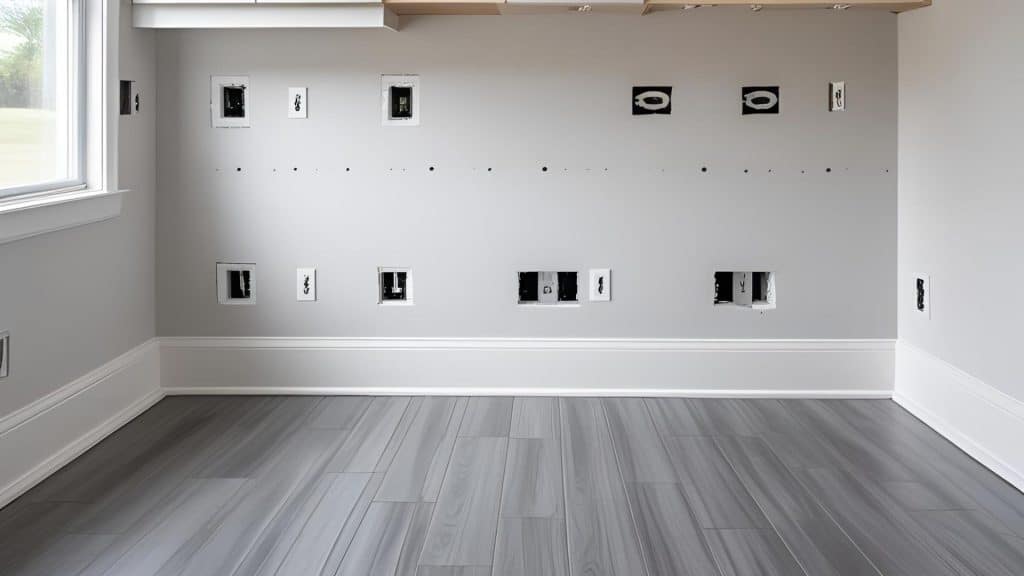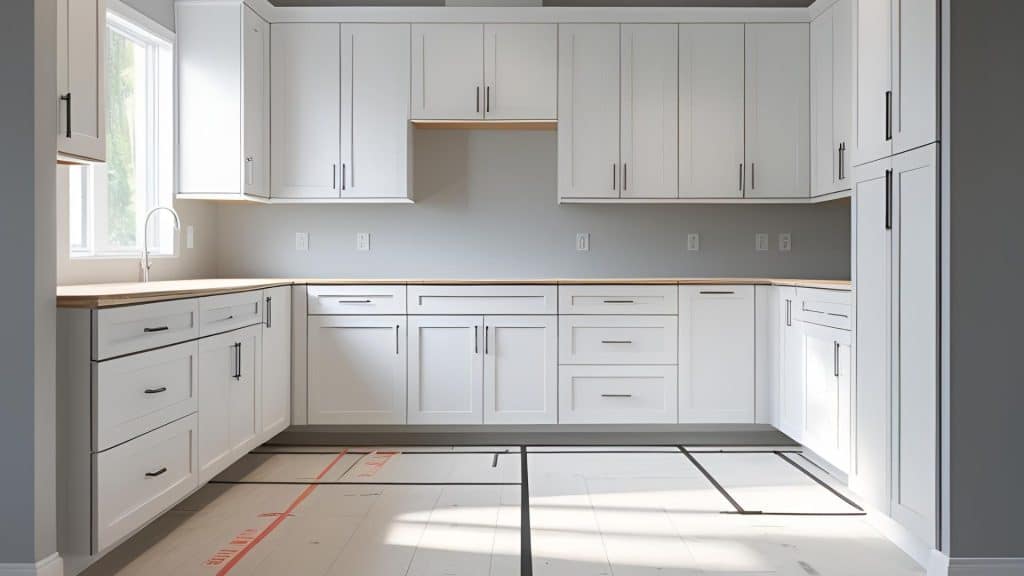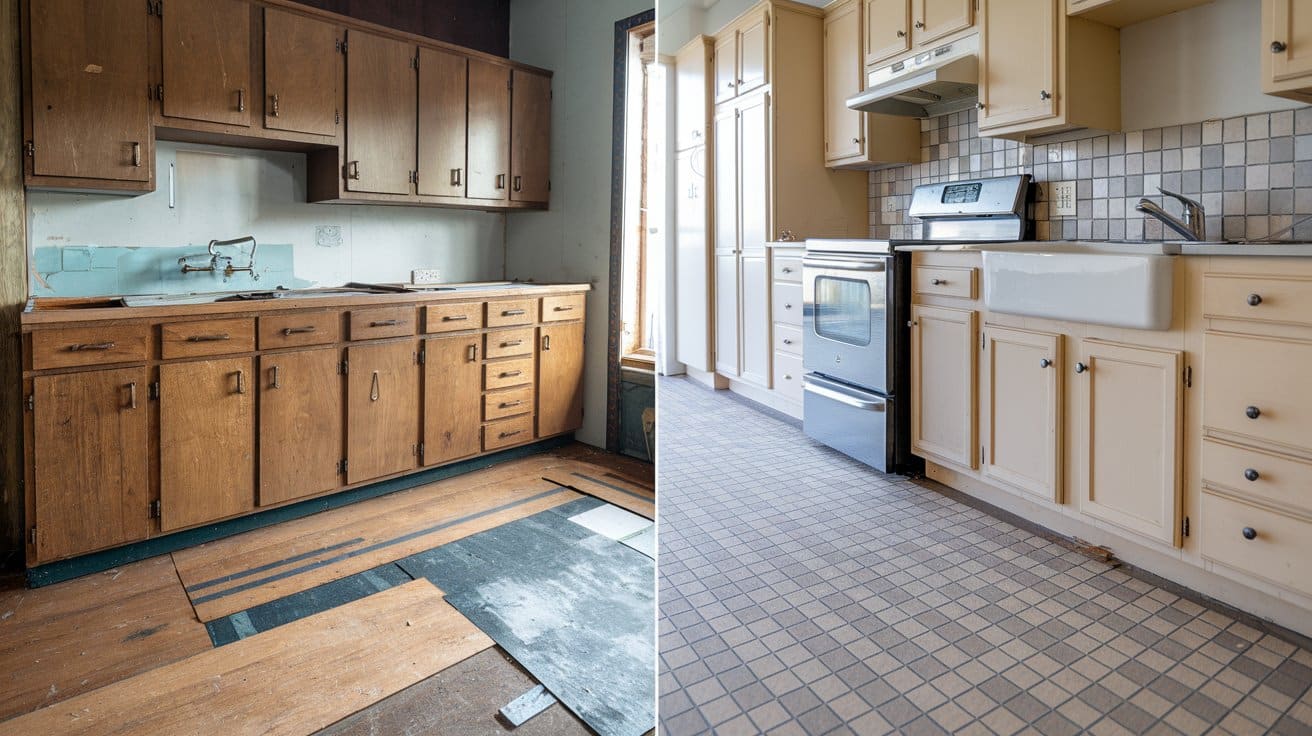Are you planning a kitchen remodel and wondering about flooring timing?
This question stumps many homeowners during renovation planning. The order of installation has a significant impact on your final results.
Vinyl flooring offers durability and style for modern kitchens. But should it go down before or after the cabinets? This decision impacts your budget and timeline.
Each approach has distinct benefits and drawbacks worth considering. Careful coordination ensures a smooth, efficient renovation process. A well-informed decision helps avoid future renovation stress.
In this blog, I’ll show you both approaches and their key differences. You’ll learn which timing works best for your specific situation and renovation goals.
What Is Vinyl Flooring: Types, Composition, and Suitability
Vinyl flooring combines synthetic components to create durable surfaces. The base layer consists of PVC resin mixed with plasticizers to improve flexibility. Stabilizers prevent degradation, while fillers add strength and reduce costs.
The middle layers include a printed design film and a clear wear layer. These protective patterns resist scratches and stains. A foam or felt backing provides comfort and sound absorption.
Types of vinyl flooring include:
- Sheet Vinyl: Continuous rolls that cover rooms without seams.
- Luxury Vinyl Plank (LVP): Separate planks that look like real wood.
- Luxury Vinyl Tile (LVT): Individual tiles replicate the appearance of stone or ceramic.
- Rigid Core Vinyl: Extra-stable options containing limestone or wood composites.
- WPC and SPC: Water-resistant choices using wood plastic or stone plastic.
Kitchens, bathrooms, and busy areas benefit from vinyl flooring. Water resistance and simple cleaning make it practical for active families. Various designs complement different home styles easily.
Why Does the Order of Installation Matter so Much?
Installation order affects multiple aspects of your renovation project. Poor timing leads to costly mistakes and rework. The sequence impacts your budget, timeline, and final appearance. Making the correct choice saves money and prevents future problems.
- Budget Implications: Installing flooring first requires more materials and labor. You’ll also pay for the square footage under the cabinets. However, this might save money on future repairs. Consider total costs, not just upfront expenses.
- Project Timeline: Flooring before cabinets adds installation time upfront. Working around cabinets later takes precision and patience. Consider which approach fits your schedule better. Some methods require multiple contractor visits.
- Future Renovations: Full-room flooring allows easier cabinet changes later. Partial flooring significantly limits your remodeling options. Think about your long-term plans carefully. Proper sequencing protects your investment and smooths the workflow.
- Professional vs. DIY Work: Some methods are better suited for professional installers than others. Complex cuts around cabinets can be a challenge for DIY enthusiasts. Assess your skill level honestly first. Mistakes cost more than hiring experts.
Pros and Cons of Installing Vinyl Flooring Before Cabinets

Installing vinyl flooring before cabinets creates a complete foundation. This traditional approach offers several advantages. However, it also presents certain challenges that need to be considered.
| Pros | Cons |
|---|---|
| Continuous flooring throughout the entire space | Uniform surface height for all fixtures and appliances |
| Easier cabinet replacement in future renovations | Risk of damage during cabinet installation |
| No visible gaps or unfinished edges | Potential for trapped moisture under cabinets |
| Simpler installation process overall | Cabinet weight might compress vinyl over time |
| Better resale value with complete flooring | Difficulty accessing the subfloor for repairs |
| Simpler toe-kick and lighting alignment | The extended project timeline initially |
Choose Flooring Before Cabinets If: Your budget allows for extra materials and labor costs. You plan to stay in your home in the long term. Future cabinet updates or layout changes seem likely. You want to achieve maximum resale value and a professional appearance.
Pros and Cons of Installing Vinyl Flooring After Cabinets

Installing vinyl flooring after cabinets saves materials and protects surfaces. This modern approach is well-suited for many renovation projects. Yet, it requires careful planning and execution.
| Pros | Cons |
|---|---|
| Lower material costs with less square footage | Visible edges where the flooring meets the cabinets |
| No risk of damage during cabinet work | Complex cutting around cabinet bases |
| Easier subfloor access for future repairs | Limited options for cabinet replacement |
| Fewer transitions and expansion gap challenges | Potential gaps if measurements aren’t precise |
| Cabinets protected from moisture below | Professional installation is often necessary |
| Immediate use of kitchen cabinets | May affect home resale value |
Choose Flooring After Cabinets If: Budget constraints require minimizing material costs as soon as possible. Your cabinets are high-quality and recently installed. You need to complete projects quickly with minimal disruption. DIY installation appeals to you despite the cutting challenges.
Factors to Consider Before You Decide
Several essential elements influence your installation decision. Each factor affects cost, time, and final results in different ways. Evaluate these aspects based on your specific kitchen situation.
1. Kitchen Layout and Design
Open floor plans benefit from continuous flooring installation throughout the space. Galley kitchens might work equally well with either approach.
Consider traffic patterns and visual flow across room transitions. Your layout determines which method looks best overall. Island placement also significantly affects your installation choice.
2. Type of Vinyl Flooring
Thicker vinyl planks can better handle cabinet weight than sheets. Rigid core options provide more stability under heavy cabinets.
Match your flooring choice to your preferred installation method. Some vinyl types require specific installation approaches for success. Click-lock systems offer different options than glue-down products.
3. Cabinet Quality and Lifespan
High-quality cabinets last for decades without needing any replacement. Lower-grade options might require updates sooner than expected.
Plan installation based on realistic expectations for cabinet longevity. Permanent cabinets suit different methods than temporary ones do. Consider whether you’ll keep or change cabinets eventually.
4. Local Building Codes
Some areas require specific installation methods strictly by law. Check local regulations before starting your renovation project in any area.
Compliance prevents costly corrections and delays in the future. Building inspectors verify that proper installation procedures have been followed during the final inspection. Permits might specify exact installation requirements for your area.
5. Moisture Concerns
Kitchens face spills and humidity regularly throughout daily use. Proper moisture barriers effectively protect both installation methods.
Consider your climate and existing ventilation systems carefully first. Water damage can quickly ruin flooring and cabinets without proper protection. Waterproof vinyl options provide superior protection compared to standard types.
Vinyl Flooring Care and Maintenance Tips
Proper maintenance can significantly extend the lifespan of your vinyl flooring. Regular care keeps surfaces looking new for years.
- Daily cleaning: Sweep or vacuum loose dirt and debris.
- Weekly mopping: Use only manufacturer-approved cleaners.
- Spill management: Wipe liquids immediately to prevent staining.
- Furniture protection: Place felt pads under heavy items.
- Temperature control: Maintain a consistent indoor climate.
- Avoid harsh chemicals: Skip bleach and abrasive cleaners.
- Regular inspections: Check edges and seams monthly.
- Professional cleaning: Schedule deep cleaning annually.
Conclusion
While each project is unique, most professionals recommend installing vinyl flooring before cabinets for long-term value and flexibility. Your specific needs determine the best path forward, ultimately.
Weigh all costs, timing, and future needs upfront. Quality installation matters more than timing alone ever will. Professional guidance helps avoid costly mistakes during renovation projects.
Take time to evaluate all the factors we’ve discussed today. Your decision impacts daily life and home value significantly. Make choices that align with your goals and circumstances.
The correct method depends on your unique kitchen situation. Thoughtful planning now prevents problems and regrets later on.
What installation method fits your kitchen project best overall? Share your thoughts or questions in the comments below.
Ready for a refresh? Explore more home improvement ideas to upgrade your space.
Frequently Asked Questions
Should I Do Cabinets or Flooring First?
Most experts recommend laying flooring first, then installing kitchen cabinets. This order simplifies the process and creates better results. Countertops and backsplash come after cabinets.
Do Cabinets Sit on Top of The Flooring?
Cabinets are typically installed on the subfloor, not finished flooring. Some exceptions exist with hardwood floors or cabinets with legs. This prevents flooring movement issues.
Does Anything Go Under Vinyl Plank Flooring?
Modern vinyl flooring usually includes an attached underlayment with moisture barriers. Products without built-in padding can be installed directly on subfloors. Cork backing requires different preparation.








